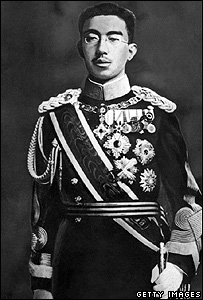Hirohito ruled Japan from December 25, 1926 to January 7, 1989. He reigned for 62 years and was the longest living monarch of modern history. His reign encompassed a tumultuos era when Japan rose to its zenith and hit the lowest point in its history.
Hirohito was born on April 29, 1901 in Tokyo. He was the eldest child of Emperor Taisho and Empress Teimei. As a child, Hirohito acted with dignity and reserve, and was known as being responsible and serious well beyond his years. After his father ascended to the throne and became Emperor of Japan, Hirohito began studying natural history. He developed a paticular interest in marine biology, and in his adulthood he was known as an expert in the subject.
On January 26, 1924, Hirohito married Princess Nagako. Their first child, Shigeko, was born in 1926. Hirohito also became Crown Prince of Japan. In 1921, Hirohito became the first Crown Prince of Japan to visit countries abroad. He visited much of Europe, including France and England.
On December 25, 1926, Hirohito became Emperor of Japan. Early in his reign, Hirohito resisted several rebellions formulated by army officers to take over the country. Japan was restless and clamoring for reform. These rebels wanted to establish a military government “lead” by the Emperor. In reality, the government would be ruled by military officers, and Hirohito would be Emperor of Japan in name only. Hirohito believed that politicians should be modest and nonmilitaristic, and disapproved of the radical military leaders.
In 1937, war broke out with China. During this war, Japan conquered Manchuria and commited many atrocities, such as killing civilians, raping women, and burning entire cities to the ground. These acts would later be considered war crimes, and the generals who authorized these acts would be tried as criminals. Next, Japanese officials made a pact with Nazi Germany and Italy. Hirohito did not approve of this pact, but he did nothing to prevent it from being made. Hirohito also disapproved of the attacks on Pearl Harbor in 1941, but once again, he did nothing to stop it. When Hiroshima was bombed in 1945, Hirohito urged his military officials to surrender, but they refused. When Nagasaki was bombed, Japanese military officers still did not want to surrender, but Hirohito forced them to.
After World War II, Hirohito was not tried as a war criminal, causing much controversy. Many claimed that he approved all of his military commanders’ decisions, while others claim that he was mild mannered and did not care about the military. General McArthur decided not to try him as a war criminal because he thought it would cause a rift between the Japanese people and Americans, and would hinder his plan to demilitarize Japan and make it a democracy.
Hirohito travelled to the United States in 1975 and formally apologized to the world for all the suffering caused under his reign. Some treated this as an acceptance of personal responsibility for the war, while others simply thought of it as a formality. Hirohito died on January 7, 1989 at the age of 87.
Interesting Fact #1: Upon becoming Emperor of Japan, Hirohito took the name Showa, which means “Enlightened Peace”. This is quite ironic, considering the fact that World War II and a bloody war with China occured during his reign.
Interesting Fact #2: During World War II, Hirohito never left his palace in Tokyo. Even when some of the buildings in the palace compound were bombed to the ground, he refused to leave. He insisted that he must suffer like his subjects were.
Interesting Fact #3: Supposedly, Hirohito was burried with a microscope in his casket, symbolic of his love of science and marine biology.
Credits: http://www.pbs.org/wgbh/amex/macarthur/peopleevents/pandeAMEX97.html, http://www.notablebiographies.com/He-Ho/Hirohito.html, 5,000 Years of Royalty by James Craughwell, Picture: http://news.bbc.co.uk/2/hi/entertainment/5248912.stm

Leave a comment